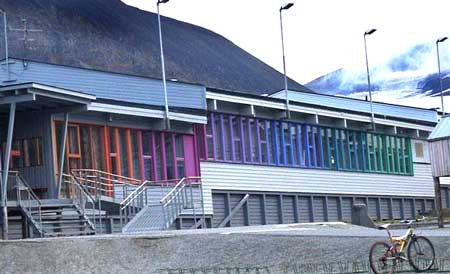Exterior painting in Chicago? Sure! However, exterior painting in the North Pole does not seem to be a likely prospect and neither does a color design consultation to develop a color scheme for an entire town of 1,400 inhabitants. Yet, both happened in a coal mining town called Longyearbyen in Norway, the most northern town on earth.
What makes it an unlikely scenario is that, in a climate this cold and dry, wood does not rot. Therefore, there is no need to use exterior painting as a means to preserve wooden structures, which is a nightmare scenario if you are a house painting contractor in the area. Consequently, without the colors that paint would have added to the décor of the town, the predominant colors, for most of the year, were black, white and every shade of gray.
Another critical factor was the wildly varying amount of light through the year, from total darkness for 3 months to twenty four hours of sun in the few summer months. The rest of the time, there are blue shadows and a sky that changes from pink, to turquoise to lilac.
Most of the town’s buildings are owned by a coal mining company. In 1981, in a bold and visionary move, the Board of Directors of the coal company hired Grete Smedal, a renowned environmental designer and color expert, to develop a color scheme for both housing and public buildings in the town. Having understood the power of color to enrich one’s environment, the Board presented Ms. Smedal with the challenge and the opportunity of a lifetime.
In 2004, I had the great pleasure and privilege to meet Grete in Trumso, Norway, at an international conference of painting contractors. After the conference , she sent me a copy of the book she had written on this unique color design and painting project.
After much study and deliberation, Grete finally settled on a color palette of almost equal whiteness, blackness and chromatic intensity. All the colors were of medium lightness, which allowed the color scheme to offer sufficient contrast in any season.
The actual exterior painting was executed in the 80s and 90s, which brought a smile to the local painting contractors. Ms. Smedal gave the school building a special color treatment. She had a row of 50+ windows painted in the colors of the rainbow. In her book, published in 2001, entitled “Longyearbyen in colors – status and challenges”, she quoted an anonymous miner who wrote the following:
“A span of the rainbow over summer wet meadow,
Is it a dream of a time you have left?
Much is forgotten, but may be not this:
The hunt in the woods for the rainbow’s end.
Just before the darkness of fall shadows the sun
You see a vision and then you see that
The end of the rainbow has hit on the school.
The treasure of Knowledge is the happiness you sought.”

Picture of Longyearbyen's School
Here is a picture of the school in the Fall:
Thanks Grete Smedal for your magical work in the North pole!
Color and painting have the power to add great value to people’s life. This is the belief that inspires everything we do at Painting in Partnership, Inc., painting contractors in the Chicago area.







 Follow
Follow

